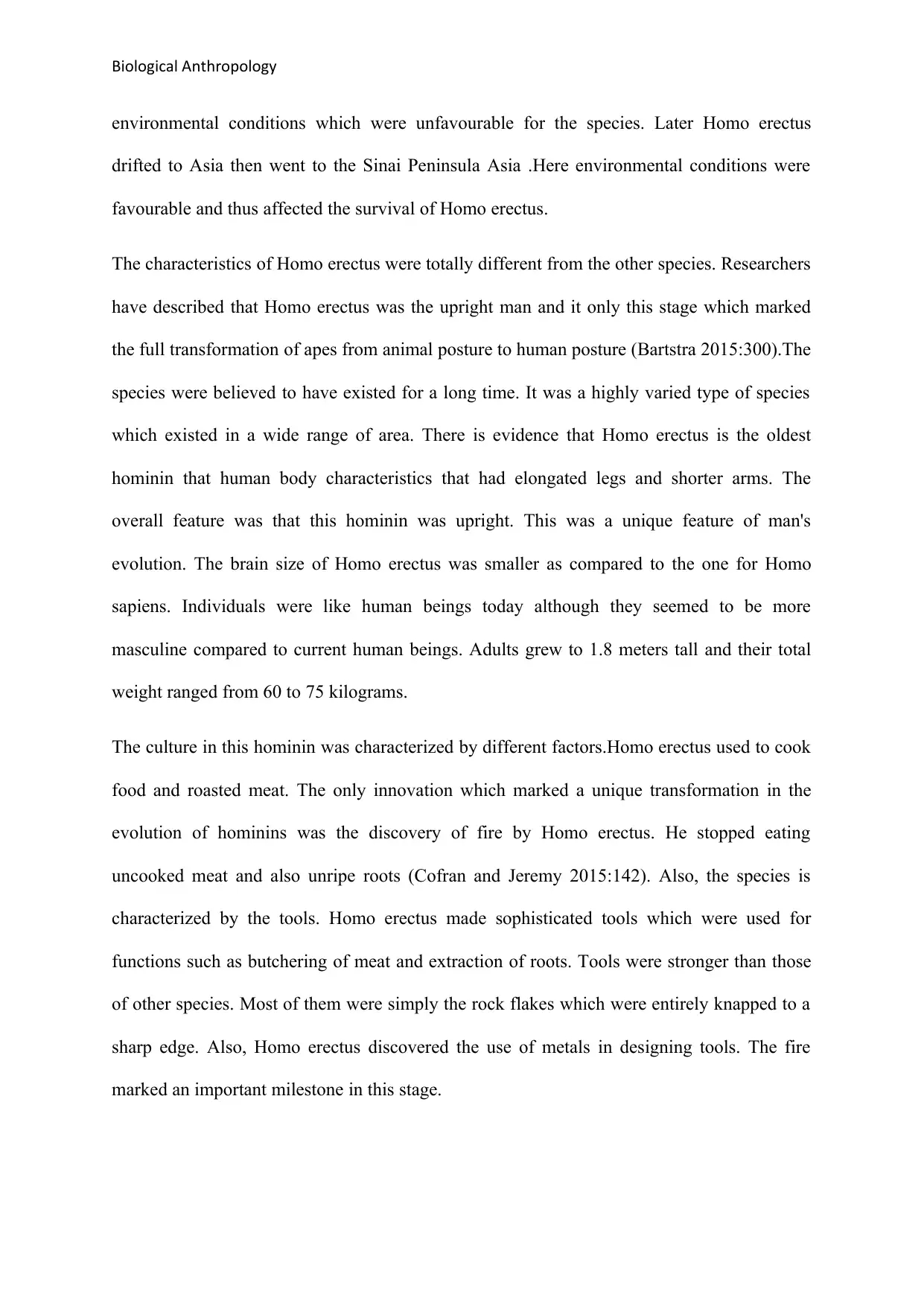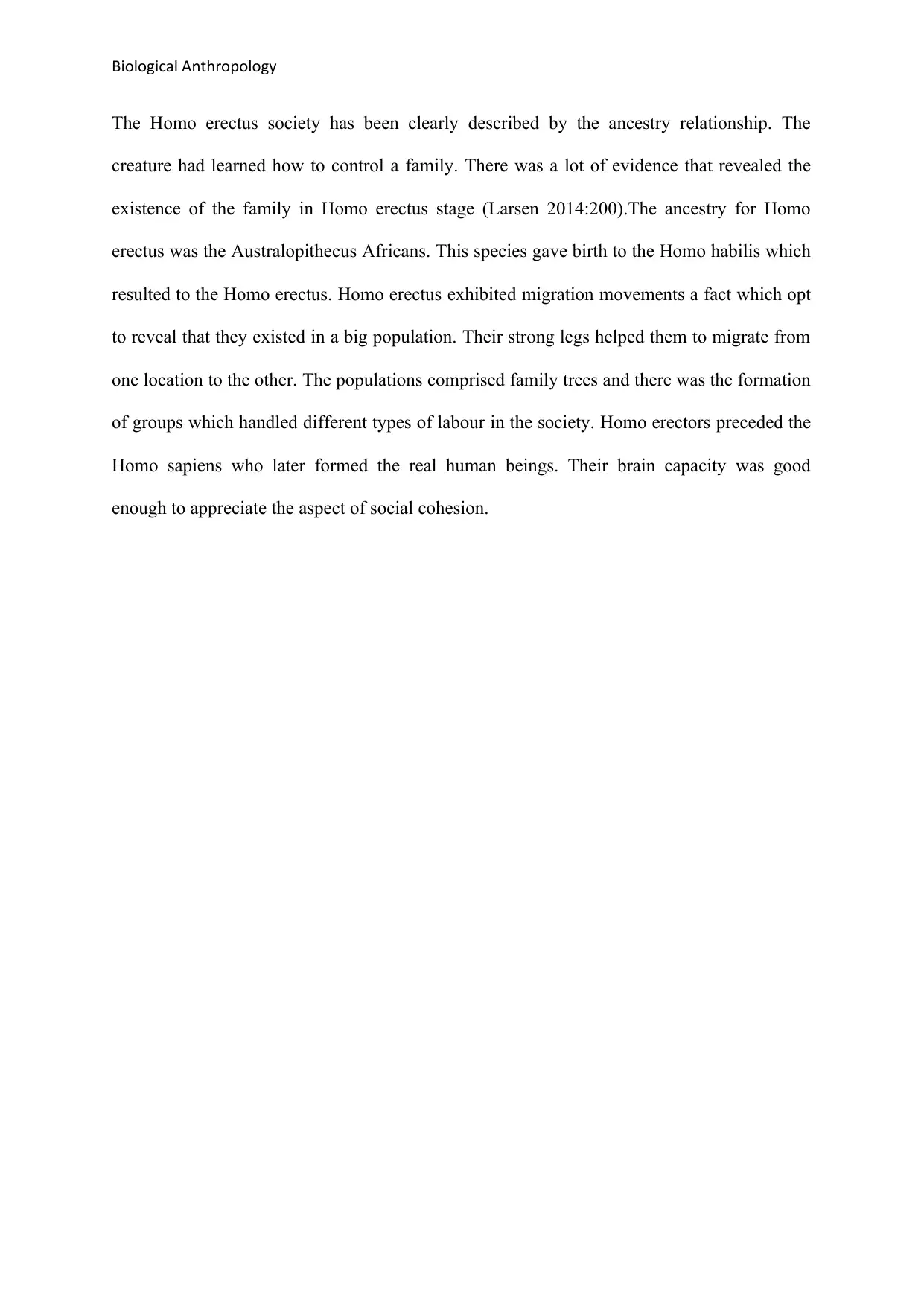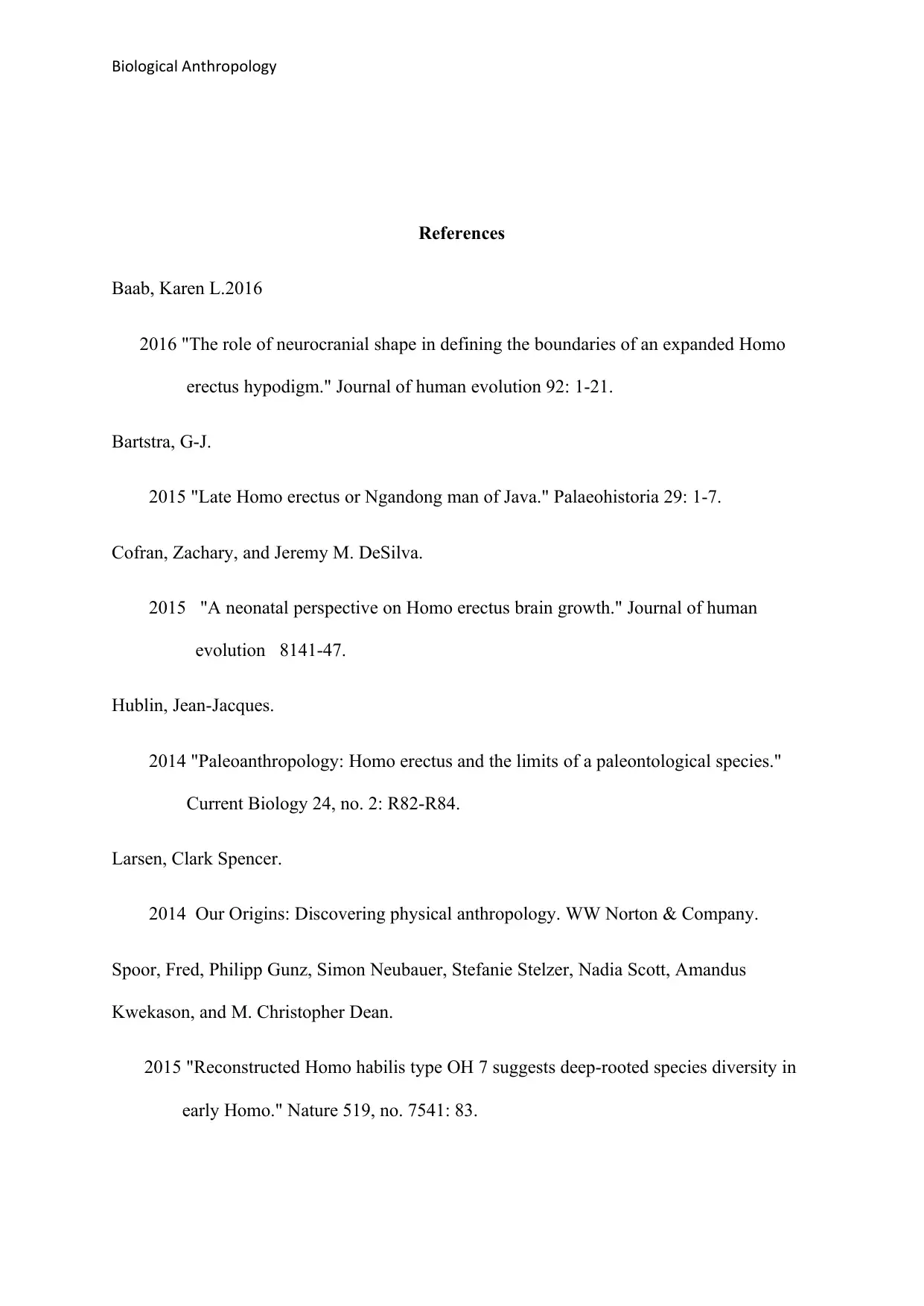Hominin Homo erectus: Characteristics, Culture, and Society
VerifiedAdded on 2023/05/30
|5
|1057
|174
AI Summary
This essay on Biological Anthropology discusses the characteristics, culture, and society of Hominin Homo erectus. It describes how Homo erectus lived, migrated, and evolved, including their use of fire, sophisticated tools, and family structures.
Contribute Materials
Your contribution can guide someone’s learning journey. Share your
documents today.

Biological Anthropology
Essay on Hominin Homo erectus.
Name
Professor
Course
Date
Essay on Hominin Homo erectus.
Name
Professor
Course
Date
Secure Best Marks with AI Grader
Need help grading? Try our AI Grader for instant feedback on your assignments.

Biological Anthropology
Generally, hominins have been described as the earliest great apes which existed 500 years
ago. The human being has evolved from these apes (Hublin 2014:76).They used to have
human characteristics which later developed to form a complex creature known as the Homo
sapiens or the current human being. Each hominin was discovered from different areas and
some had some shared characteristics. Some of the hominin discovered by historians included
the Homo erectus, Homo sapiens, and Homo habilis among others. The chronological order
in which these species existed tries to remind the human beings on some of the stages they
have passed. The hominin is believed to possess little characteristics connected with the
current human beings. The evolution continued in millions of years until the current Homo
sapiens.
In the discussion have selected the homo erectus species as the only hominin to discuss.The
content of homo erectus has been well articulated by summarising its culture, describing the
environment where the species of homo erectus were found, discussing the culture of homo
erectus and lastly revealing on some aspects that try to describe the society and the
relationship exhibited in this stage of evolution (Baab 2016:312).
Homo erectus has been identified as the longest living hominin (Spoor et al.2015:51).This
has been clearly described by the researchers who discovered Homo erectus species in East
Africa 1.9 million years ago. Evidence shows that a lot of hominins used to live in
Africa.Some species were discovered in Lake Turkana. However, there are some discoveries
which show that some species also existed in Asia and some parts of Indonesia. The fossil
evidence of Homo erectus has been identified in western Asia in 1991 that existed 1.8-1.85
million years old. The overall environment where Homo erectus lived we can say it was
Africa. Most of the Homo erectus fossils were discovered in different parts of Africa.
Researchers show that these species later migrated from Africa and then spread out to
different locations of the world. The migration was due to some reasons such as the adverse
Generally, hominins have been described as the earliest great apes which existed 500 years
ago. The human being has evolved from these apes (Hublin 2014:76).They used to have
human characteristics which later developed to form a complex creature known as the Homo
sapiens or the current human being. Each hominin was discovered from different areas and
some had some shared characteristics. Some of the hominin discovered by historians included
the Homo erectus, Homo sapiens, and Homo habilis among others. The chronological order
in which these species existed tries to remind the human beings on some of the stages they
have passed. The hominin is believed to possess little characteristics connected with the
current human beings. The evolution continued in millions of years until the current Homo
sapiens.
In the discussion have selected the homo erectus species as the only hominin to discuss.The
content of homo erectus has been well articulated by summarising its culture, describing the
environment where the species of homo erectus were found, discussing the culture of homo
erectus and lastly revealing on some aspects that try to describe the society and the
relationship exhibited in this stage of evolution (Baab 2016:312).
Homo erectus has been identified as the longest living hominin (Spoor et al.2015:51).This
has been clearly described by the researchers who discovered Homo erectus species in East
Africa 1.9 million years ago. Evidence shows that a lot of hominins used to live in
Africa.Some species were discovered in Lake Turkana. However, there are some discoveries
which show that some species also existed in Asia and some parts of Indonesia. The fossil
evidence of Homo erectus has been identified in western Asia in 1991 that existed 1.8-1.85
million years old. The overall environment where Homo erectus lived we can say it was
Africa. Most of the Homo erectus fossils were discovered in different parts of Africa.
Researchers show that these species later migrated from Africa and then spread out to
different locations of the world. The migration was due to some reasons such as the adverse

Biological Anthropology
environmental conditions which were unfavourable for the species. Later Homo erectus
drifted to Asia then went to the Sinai Peninsula Asia .Here environmental conditions were
favourable and thus affected the survival of Homo erectus.
The characteristics of Homo erectus were totally different from the other species. Researchers
have described that Homo erectus was the upright man and it only this stage which marked
the full transformation of apes from animal posture to human posture (Bartstra 2015:300).The
species were believed to have existed for a long time. It was a highly varied type of species
which existed in a wide range of area. There is evidence that Homo erectus is the oldest
hominin that human body characteristics that had elongated legs and shorter arms. The
overall feature was that this hominin was upright. This was a unique feature of man's
evolution. The brain size of Homo erectus was smaller as compared to the one for Homo
sapiens. Individuals were like human beings today although they seemed to be more
masculine compared to current human beings. Adults grew to 1.8 meters tall and their total
weight ranged from 60 to 75 kilograms.
The culture in this hominin was characterized by different factors.Homo erectus used to cook
food and roasted meat. The only innovation which marked a unique transformation in the
evolution of hominins was the discovery of fire by Homo erectus. He stopped eating
uncooked meat and also unripe roots (Cofran and Jeremy 2015:142). Also, the species is
characterized by the tools. Homo erectus made sophisticated tools which were used for
functions such as butchering of meat and extraction of roots. Tools were stronger than those
of other species. Most of them were simply the rock flakes which were entirely knapped to a
sharp edge. Also, Homo erectus discovered the use of metals in designing tools. The fire
marked an important milestone in this stage.
environmental conditions which were unfavourable for the species. Later Homo erectus
drifted to Asia then went to the Sinai Peninsula Asia .Here environmental conditions were
favourable and thus affected the survival of Homo erectus.
The characteristics of Homo erectus were totally different from the other species. Researchers
have described that Homo erectus was the upright man and it only this stage which marked
the full transformation of apes from animal posture to human posture (Bartstra 2015:300).The
species were believed to have existed for a long time. It was a highly varied type of species
which existed in a wide range of area. There is evidence that Homo erectus is the oldest
hominin that human body characteristics that had elongated legs and shorter arms. The
overall feature was that this hominin was upright. This was a unique feature of man's
evolution. The brain size of Homo erectus was smaller as compared to the one for Homo
sapiens. Individuals were like human beings today although they seemed to be more
masculine compared to current human beings. Adults grew to 1.8 meters tall and their total
weight ranged from 60 to 75 kilograms.
The culture in this hominin was characterized by different factors.Homo erectus used to cook
food and roasted meat. The only innovation which marked a unique transformation in the
evolution of hominins was the discovery of fire by Homo erectus. He stopped eating
uncooked meat and also unripe roots (Cofran and Jeremy 2015:142). Also, the species is
characterized by the tools. Homo erectus made sophisticated tools which were used for
functions such as butchering of meat and extraction of roots. Tools were stronger than those
of other species. Most of them were simply the rock flakes which were entirely knapped to a
sharp edge. Also, Homo erectus discovered the use of metals in designing tools. The fire
marked an important milestone in this stage.

Biological Anthropology
The Homo erectus society has been clearly described by the ancestry relationship. The
creature had learned how to control a family. There was a lot of evidence that revealed the
existence of the family in Homo erectus stage (Larsen 2014:200).The ancestry for Homo
erectus was the Australopithecus Africans. This species gave birth to the Homo habilis which
resulted to the Homo erectus. Homo erectus exhibited migration movements a fact which opt
to reveal that they existed in a big population. Their strong legs helped them to migrate from
one location to the other. The populations comprised family trees and there was the formation
of groups which handled different types of labour in the society. Homo erectors preceded the
Homo sapiens who later formed the real human beings. Their brain capacity was good
enough to appreciate the aspect of social cohesion.
The Homo erectus society has been clearly described by the ancestry relationship. The
creature had learned how to control a family. There was a lot of evidence that revealed the
existence of the family in Homo erectus stage (Larsen 2014:200).The ancestry for Homo
erectus was the Australopithecus Africans. This species gave birth to the Homo habilis which
resulted to the Homo erectus. Homo erectus exhibited migration movements a fact which opt
to reveal that they existed in a big population. Their strong legs helped them to migrate from
one location to the other. The populations comprised family trees and there was the formation
of groups which handled different types of labour in the society. Homo erectors preceded the
Homo sapiens who later formed the real human beings. Their brain capacity was good
enough to appreciate the aspect of social cohesion.
Secure Best Marks with AI Grader
Need help grading? Try our AI Grader for instant feedback on your assignments.

Biological Anthropology
References
Baab, Karen L.2016
2016 "The role of neurocranial shape in defining the boundaries of an expanded Homo
erectus hypodigm." Journal of human evolution 92: 1-21.
Bartstra, G-J.
2015 "Late Homo erectus or Ngandong man of Java." Palaeohistoria 29: 1-7.
Cofran, Zachary, and Jeremy M. DeSilva.
2015 "A neonatal perspective on Homo erectus brain growth." Journal of human
evolution 8141-47.
Hublin, Jean-Jacques.
2014 "Paleoanthropology: Homo erectus and the limits of a paleontological species."
Current Biology 24, no. 2: R82-R84.
Larsen, Clark Spencer.
2014 Our Origins: Discovering physical anthropology. WW Norton & Company.
Spoor, Fred, Philipp Gunz, Simon Neubauer, Stefanie Stelzer, Nadia Scott, Amandus
Kwekason, and M. Christopher Dean.
2015 "Reconstructed Homo habilis type OH 7 suggests deep-rooted species diversity in
early Homo." Nature 519, no. 7541: 83.
References
Baab, Karen L.2016
2016 "The role of neurocranial shape in defining the boundaries of an expanded Homo
erectus hypodigm." Journal of human evolution 92: 1-21.
Bartstra, G-J.
2015 "Late Homo erectus or Ngandong man of Java." Palaeohistoria 29: 1-7.
Cofran, Zachary, and Jeremy M. DeSilva.
2015 "A neonatal perspective on Homo erectus brain growth." Journal of human
evolution 8141-47.
Hublin, Jean-Jacques.
2014 "Paleoanthropology: Homo erectus and the limits of a paleontological species."
Current Biology 24, no. 2: R82-R84.
Larsen, Clark Spencer.
2014 Our Origins: Discovering physical anthropology. WW Norton & Company.
Spoor, Fred, Philipp Gunz, Simon Neubauer, Stefanie Stelzer, Nadia Scott, Amandus
Kwekason, and M. Christopher Dean.
2015 "Reconstructed Homo habilis type OH 7 suggests deep-rooted species diversity in
early Homo." Nature 519, no. 7541: 83.
1 out of 5
Related Documents
Your All-in-One AI-Powered Toolkit for Academic Success.
+13062052269
info@desklib.com
Available 24*7 on WhatsApp / Email
![[object Object]](/_next/static/media/star-bottom.7253800d.svg)
Unlock your academic potential
© 2024 | Zucol Services PVT LTD | All rights reserved.





